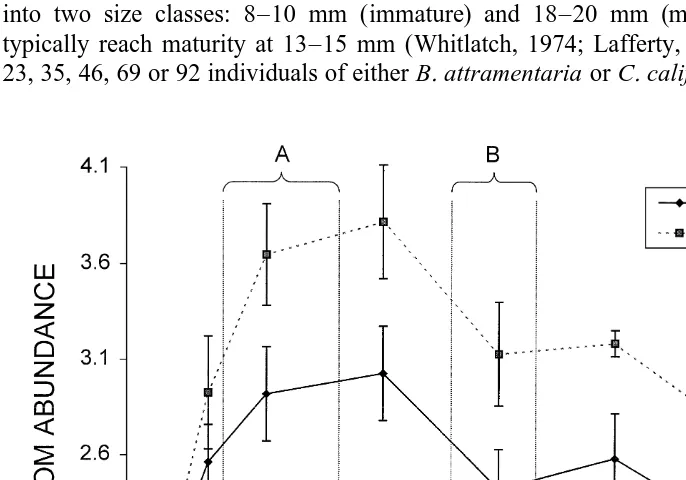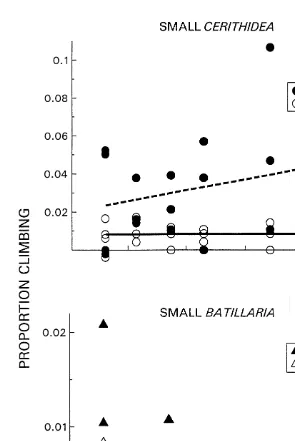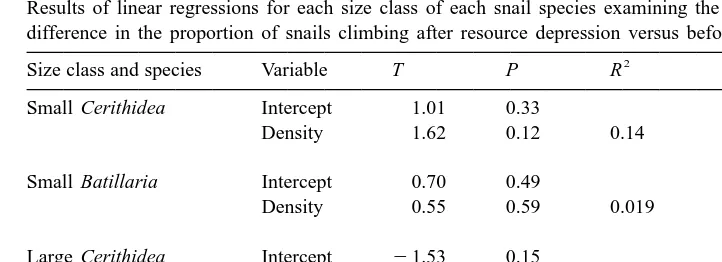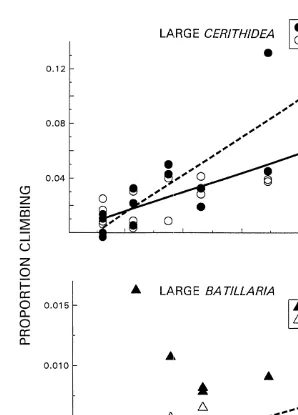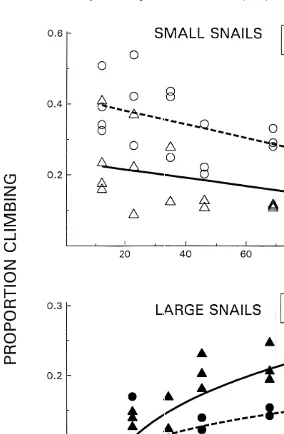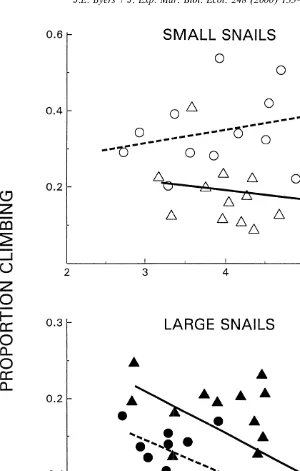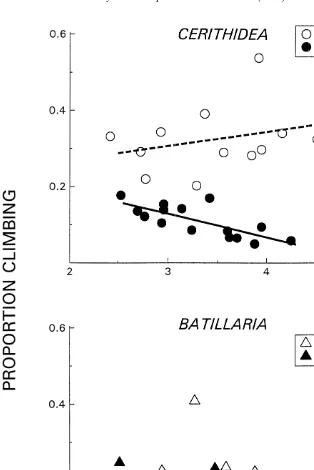L
Journal of Experimental Marine Biology and Ecology 248 (2000) 133–150
www.elsevier.nl / locate / jembe
Effects of body size and resource availability on dispersal in
a native and a non-native estuarine snail
* James E. Byers
Department of Ecology, Evolution, and Marine Biology, University of California, Santa Barbara, CA93106, USA
Received 21 July 1999; received in revised form 21 December 1999; accepted 10 January 2000
Abstract
I manipulated snail densities of two coexisting species of salt marsh snail, Cerithidea
californica Haldeman (native) and Batillaria attramentaria Sowerby (non-indigenous) to
investi-gate how resource levels set by intraspecific competition may influence dispersal rates. I used two distinct size classes of the snails (mature and immature) to determine if the effects of competition on dispersal differed between developmental stages of a consumer. Dispersal attempts were measured within enclosure pens by counting snails climbing the sides of the enclosure. The influence of snail density per se and resource levels (which were set by snail densities) on dispersal rates were separated by comparing responses of snails to density before and after resources became depleted. For large snails of both species, dispersal increased as resource levels decreased, supporting the hypothesis that competition influences dispersal rates. Small snails of both species, in contrast, always dispersed at relatively higher rates than larger individuals, but were not influenced by variation in resource levels. This result corroborates other studies that have shown reduced competition in these species at smaller size, and suggests that another mechanism, such as genetically coded behavior to disperse when young, influences their behavior. Previous experi-ments demonstrated Batillaria’s superior resource conversion efficiency; therefore, I had hypoth-esized that for any given resource level, Cerithidea would disperse more, because it was more affected by resource availability. Adult Batillaria, however, responded more sensitively to resource levels (i.e., dispersed more at any given resource level) than Cerithidea. This counter-intuitive result illustrates the potential importance of genetic limitations on behavioral responses available to a species. Constraints on behavioral responses may have been accentuated since
Batillaria is a non-indigenous species whose evolved behavioral responses are not necessarily
adapted to its present, non-native environment. 2000 Elsevier Science B.V. All rights reserved.
Keywords: Batillaria attramentaria; Cerithidea californica; Climbing; Emigration; Evolutionary history; Exotic species; Exploitative competition; Non-indigenous species
*Correspondence address: Friday Harbor Marine Laboratory, 620 University Road, Friday Harbor, WA 98250, USA (tel.: 11-360-378-2165; fax: 11-206-543-1273).
E-mail address: [email protected] (J.E. Byers)
1. Introduction
Dispersal is a commonly observed short-term response to competition among mobile species (Holbrook and Schmitt, 1989; Korona, 1991; Naslund et al., 1993; Weins et al., 1993; Iribarne et al., 1994; Crowe and Underwood, 1999). Increases in competitor density may intensify resource depletion or interference behaviors that create unfavor-able conditions and stimulate departure (Underwood, 1977; Levinton, 1979; Branch and Branch, 1981). By necessity however, experiments used to quantify competitive effects on vital rates typically rely on enclosures (e.g., cages, pens) to ensure that a constant density of competitor is maintained throughout the experimental period, and secondarily to ensure initially measured organisms are retrievable at termination. Because dispersal is prohibited, competitive effects measured inside enclosures may be artificially intensified because containment disallows a natural ‘‘pressure release valve’’ of dispersal. Nonetheless, in the majority of enclosure experiments the ability of dispersal to potentially mitigate measured competitive effects is often ignored, or only occasion-ally speculated (e.g., Lee, 1996). Creative attempts to capture both responses have been rare (see Denno and Roderick, 1992; Fenske, 1997).
To investigate intraspecific competitive interactions of a native and a non-indigenous salt marsh snail, I enclosed snails using a range of intraspecific densities. Byers (in press) presents quantification of the intraspecific competitive effects of snail density on resource availability and snail growth rates. Here I present my effort to simultaneously quantify levels of (attempted) dispersal due to competition while still allowing accurate quantification of the aforementioned intraspecific competitive effects of snail density. To quantify snail responses to constant density and snail dispersal attempts concurrently, I capitalized on an aspect of these snails’ biology – that they readily climb vertical substrates. To measure the number of snails trying to disperse from enclosure pens, I counted daily the number of snails climbing the sides of the enclosures before placing them back onto the mud bottom of the enclosures.
1.1. The study system
Cerithidea californica Haldeman is an epifaunal grazing snail whose habitat in
northern California has been invaded by Batillaria attramentaria Sowerby, an ecologi-cally similar species (Byers, in press). Both snails share the same limited food resource, epipelic diatoms (Whitlatch and Obrebski, 1980), and have been shown to interact almost exclusively through exploitative competition (Byers, in press). From an enclosure experiment I determined that while both species’ per capita effect on resource levels is virtually identical, Batillaria achieves a marked advantage over Cerithidea through its superior resource conversion efficiency (Byers, in press). For a given level of resource
Batillaria adds on average 20–30% more tissue mass than Cerithidea during the
growing season – an advantage that translates into faster population growth and is a sufficient mechanism to account for displacement of the native snail (Byers, in press). Heightened metabolic efficiency in general has been demonstrated to decrease a species’ sensitivity to competition for shared resources (Clarke, 1996; Murdoch et al., 1996; Baruch and Goldstein, 1999; Bystrom and Garcia-Berthou, 1999). The species appear to have similar capacities for movement, as large snails of both species have been observed to move similar net distances of 9–10 cm per day over the marsh surface (J.E. Byers, unpublished data). Both snails are frequently observed clinging to vertical surfaces such as vegetation (Salicornia virginica and Distichlis spicata), rocks, and woody debris in the marsh (McDermott, 1996, J. Byers, personal observations). During a cumulative 2-h search over two tidal series I found 324 snails of both species climbing vertical surfaces. Because I use climbing as a measure of snail dispersal it is important to know whether the snails may be climbing for reasons other than attempted dispersal. Dispersal in at least one snail, Hydrobia ventrosa, has been demonstrated due to food limitation (Levinton, 1979). Climbing in aquatic molluscs, however, has often been explained as an escape from subtidal predators (Warren, 1985; Main, 1987; Vaughn and Fisher, 1988; McKillup and McKillup, 1993; Duncan and Szelistowski, 1998), behavioral modification due to infections of trophically-transmitted parasites (Levri and Lively, 1996; McCoy and Nudds, 1997), and alleviation of harsh physical factors such as substrate temperature (McBride et al., 1989; Williams and Appel, 1989; McGuinness, 1994). In the
Cerithidea –Batillaria system however, these typically implicated stimuli are unlikely to
potential environmental stressors for these snails, freshwater run-off and sedimentation, are virtually absent in the summer months when this study was conducted (McDermott, 1996, J. Byers personal observation). In any event, demonstration of climbing as a density and resource dependent process supports competition as the predominant stimulus for dispersal.
As the role of exploitative competition in this system (Byers, in press) and among other gastropods is strong (Underwood, 1978; Branch and Branch, 1980; Levinton, 1985; Skilleter and Underwood, 1993), I hypothesized that resources would decrease with increasing snail density, causing snails to disperse more. If dispersal is motivated primarily by low levels of resources, when resources are high the relationship between dispersal and snail density should be weak regardless of snail density. At a later sampling time however, I expected density would exert a strong effect on snail dispersal since resources were likely to become depressed in high-density treatments and remain high in low density treatments. This differential effect of snail density through time would manifest itself as significant effect of density on the difference in snail dispersal rates after and before resource depression. Additionally, from my previous studies on these snails I hypothesized that because Cerithidea is impacted more heavily than
Batillaria by low resource availability, Cerithidea should disperse at a higher rate than Batillaria as a means to seek areas with less exploited resources. Conversely, because Batillaria converts resource more efficiently than its competitor I expected it would
tolerate lower resource levels and disperse less than Cerithidea for any given level of resource. Since small snails experience reduced effects of competition due to lower quantities of resource needed, i.e., resources are not as limiting (Byers, in press), I expected a weakened density dependent dispersal response to resource levels in small snails relative to large snails. For the same reason, the absolute proportion of small snails that disperse in comparison to large snails should be less if the behavior is motivated entirely by competition. Alternatively, heightened predation or general dispersal tendencies may induce small snails to disperse more frequently than large snails.
2. Methods
2
Batillaria 24.4 mm65.26 per 0.1 m ] and similar mean sizes [Cerithidea: 21.2 mm60.80 (S.E.); Batillaria: 17.2 mm60.59]. Pens were constructed of 2 mm clear Vexar mesh formed into cylinders 35 cm in diameter which I inserted 8 cm into the mud
2
substrate of the marsh; each pen thus enclosed |0.1 m of natural marsh bottom and protruded 0.42 m above the mud surface. The pens had open tops to minimize effects of shading on diatom growth. I removed all snails from the pens and rubbed each mud bottom by hand to ensure that all snails had been removed and to homogenize any initial spatial variability in epipelic diatom densities. Analysis of this technique indicated that this rubbing is effective at reducing diatom levels to near zero and results in a rapid recovery, even in the presence of grazers, peaking 17–18 days after rubbing and settling to stable levels about 27–28 days after rubbing (Fig. 1). After rubbing the pens were left undisturbed for three days before initiating the experiment.
During these three days I collected snails and sorted them in the laboratory by species into two size classes: 8–10 mm (immature) and 18–20 mm (mature). Both species typically reach maturity at 13–15 mm (Whitlatch, 1974; Lafferty, 1993a). I placed 12, 23, 35, 46, 69 or 92 individuals of either B. attramentaria or C. californica from a single
2 2
Fig. 1. Diatom abundance (mm diatom surface area /mm sediment surface area) at highest density (43
size class into each pen. Respectively, these treatment levels represented 1 / 2 ambient, ambient, 1.53 ambient, 23 ambient, 33 ambient and 43 ambient intraspecific densities. Because similar sized snails of each species affect their food resource identically, and because the snails’ interact almost exclusively through their impacts on the shared resource (Byers, in press), the response of each snail in these intraspecific treatments should reflect its response to interspecific conditions as well. I used three replicates for each density level except for the 1 / 2 ambient treatment, for which I used four. During each morning low tide after addition of the snails to the pens I brushed snails off the sides of the enclosure pens to prevent their escape, to prevent snails from being able to feed on diatoms colonizing the pen walls, and to maintain the snails on the mud bottom of the pen at the proper density. I began recording counts of these climbing snails found on the sides of enclosures only after the experiment had been running for three days so that the snails could fully recover from any potential effects of handling during set-up.
In order to tease apart the effects of density per se and resource levels (which were set by varying snail densities) on climbing behavior, I performed low tide counts in two blocks – one while resources were reaching a peak (days 8–17) and one after resources reached their lowest stable levels (days 28–35). I define the resource stable state as the lowest level of resource given a constant density of consumers. Comparison of sampling times to diatom responses through time at highest and lowest grazer densities confirmed that these sampling blocks were squarely within time periods that should have corresponded to the highest and lowest resources available during the experiments (Fig. 1). To determine if snails exhibited density-dependent dispersal behavior before resources became limiting, I regressed the proportion of climbing snails against snail density during peak resource availability. To compare the effect of snail density on the change in dispersal after resources had declined to steady state levels I regressed the difference in the proportion of snails dispersing between peak and steady state sampling blocks against snail density for each size class of each species of snail. The intercept was examined for significant differences from zero that would indicate an overall increase (or decrease) in dispersal at lower resource availability. A significant effect of density on the difference in the proportion of snails climbing post and pre resource depression would indicate a differential effect of density during the period of lower resource availability. Since the same snails were used in high and low resource measurement periods, analyses on the difference in climbing rates between the two time periods for each enclosure pen also should correct for any within cage correlation between the two sample periods. To normalize the distribution data on proportion of snails climbing I analyzed the data after arcsine squareroot transformation.
sampling, low tide counts were not recorded during the block of days that high tide counts were performed.
Dispersal and effects of snails on the food levels might vary through the experiment as a consequence of changes in snail densities; therefore, I replaced dead snails in the pens every five days. Mortality, however, was quite low (,3%). The mean number of snails (6S.E.) that escaped daily, i.e., climbed or floated out of the enclosure pens, was low (0.1460.03), with a slight trend of increasing escapees in both species as the density of large snails increased. These missing snails were replaced within 24 h when their absence was detected during the following low tide counts. The level of parasitized snails in the experiment (determined after termination of the experiment by dissecting snail gonads) of both species combined was also low (,6.5%). In any event, parasites should not have influenced the response of the microalgal resource to snail grazing since infected snails have been shown to have the same effect on the resource as uninfected snails (Lafferty, 1993b).
To measure the final density of diatoms in pens after exposure to snail grazing, I cored the bottoms of all pens at the end of the experiment. I extracted three or four sediment cores from each pen with modified plastic syringes (diameter51 cm) to a depth of 6 mm, pooled all cores from each pen in a single scintillation vial, and immediately preserved the samples in 6% Lugol’s solution in sterilized seawater. Samples were processed in the lab where I both counted and measured the surface area of diatoms cells in subsamples with a digitizing pad under a light microscope at 4003 to calculate the total surface area of resource available to the snails (for exact protocol, see Byers, in
2 press). With the exception of the 1.53 ambient density treatment (35 snails / 0.1 m ) for small snails and the few pens that were lost during the experiment, total surface area of diatom cells per area of sediment surface sampled was quantified for all pens. I used ANCOVA to test for effects of snail density and resource levels for differences in the dispersal rates between the two size classes of each species and between the two species at the same size class at high tide. To meet the assumption of linearity necessary for ANCOVA I log transformed snail densities to analyze the effect of snail density on dispersal of large snails. As for previous low tide analyses, the proportion of snails climbing was arcsine squareroot transformed.
3. Results
3.1. Low tide
During low tide both species in the small size class were found on the pen walls at low frequencies (Fig. 2). In fact, Batillaria was seldom found on the sides at all. For each species at the small size class, climbing responses were not significantly density
2
dependent during peak resource availability (Cerithidea r 50.001, P.0.96; Batillaria 2
Table 1
Results of linear regressions for each size class of each snail species examining the effect of density on the
a
difference in the proportion of snails climbing after resource depression versus before resource depression
2
Size class and species Variable T P R
Small Cerithidea Intercept 1.01 0.33
Corresponding T and P values are reported for each variable in the model along with the overall fit of the
2
model to the data (R ). The proportions of climbing snails were arcsine squareroot transformed.
low resource availability and exhibited no differential effect of density in the different sampling periods (Table 1).
Large Cerithidea and Batillaria climbed significantly more during steady state resource availability than at peak abundance, but only at higher snail densities (Table 1). For large Batillaria, dispersal rates were not dependent on snail density at peak resource
2
availability (r 50.016, P.0.6) (Fig. 3). Large Cerithidea, however, had a significant 2
climbing response to density both at peak resource availability (r 50.68, P,0.0002) 2
and at steady state (r 50.77, P,0.0001). However, Cerithidea’s density dependent response was twice as strong after resources were scarcer (compare Cerithidea slopes Fig. 3).
3.2. High tide
At high tide a higher proportion of all size classes and species of snails were found on the pen walls than had been found at low tide (Fig. 4). Small Batillaria did not exhibit a
2
significant change in dispersal with increasing density (r 50.15, P.0.13), while small 2
Cerithidea dispersed significantly less with increasing density (r 50.28, P,0.025). Mean proportions of small climbing Batillaria and Cerithidea differed significantly (ANCOVA F1,34527.6, P,0.00001). The species at the large size class responded at significantly different rates with increases in density (ANCOVA log linearized data
F1,3358.77, P,0.006). Both species at the large size class exhibited significant increases in the proportion climbing with increasing density (log linearized data
2 2
Cerithidea: r 50.63, P,0.0004; Batillaria r 50.77, P,0.000001).
In addition to snail density, resource levels also significant affected dispersal rates of
2 2
large snails (Cerithidea r 50.60, P,0.0007; Batillaria r 50.32, P,0.01) (Fig. 5). Specifically, large snails dispersed less when resources were more abundant. Small snails, however, did not exhibit significant changes in dispersal with variation in
2 2
Fig. 3. The effect of density of large C. californica (s,d) and B. attramentaria (^,m) on the proportion of snails found on enclosure walls at low tide at peak resource abundance (open symbols, –) and at lowest resource abundance (darkened symbols, - - -). The slopes of the climbing responses of Cerithidea at peak (0.002) and steady state (0.004) levels of resource abundance differed significantly (timing3density effect F1, 2956.0, P,0.02). For Batillaria, its climbing responses at peak and steady state resource levels also differed significantly (F1, 3754.7, P,0.037).
5). When comparing between species within a size class, large Batillaria climbed significantly more than large Cerithidea at any given density of resource (F1, 3356.7,
Fig. 4. The effect of density of small and large B. attramentaria (^,m, –) and C. californica (s,d, - - -) on the number of snails found on enclosure walls at high tide.
density, small snails of both species differed significantly in the absolute magnitude of their dispersal responses with Cerithidea climbing more than Batillaria (F1, 29516.6,
(Fig. 6). Compared to large Batillaria, small Batillaria climbed significantly more for a given resource level (F1, 3355.43, P,0.027) (Fig. 6).
4. Discussion
Density and resource dependent dispersal by adult Cerithidea and Batillaria indicate that competition for a shared resource can induce dispersal; as resources became scarce, particularly within high density treatments, snails climbed more. Since resource levels in this experiment were set by snail density, the pre- versus post-resource depression comparisons help to separate the effect of density per se (interference competition) from the effects of resource levels (exploitative competition) on dispersal. Large Batillaria did not demonstrate a significant dispersal response to density when resources were high, but did once resources became depressed. This switch implicates exploitative competition as a predominant agent affecting its dispersal response. Large Cerithidea exhibited a significant response to density while resources were high, indicating either an effect of interference competition or exploitative competition due to an unusually high demand for resources. In either case, Cerithidea’s dispersal rate after definitive resource depression doubles in magnitude. Dispersal thus appears to play a sizable role in attempting to alleviate short-term effects of exploitative competition, particularly among the larger, more metabolically sensitive snails.
mechanisms by holding confounding factors such as desiccation relatively constant, however, the absolute rates of behavior McGuinness reports may be underestimated since data were not gathered from high tide also.
This problem of inappropriate sample time is, of course, not limited to studies on snail dispersal, or even high versus low tide sampling problems, but applies to other ecological studies where sampling times are chosen primarily due to logistical constraints or convenience to the researcher. Some researchers have exposed prominent examples of such sampling, where intervening forces to operate between the initiation of a process or behavior and measurement by the researcher, and include the use of counts of recruits of planktonic organisms as a proxy for their initial settlement (Keough and Downes, 1982; Schmitt and Holbrook, 1996) and diurnal samples of predominantly nocturnal processes (Holbrook and Schmitt, in press; Robles, 1996).
Despite superior resource conversion efficiency, Batillaria at high tide appeared less tolerant of changes in resource levels, as it dispersed more than Cerithidea for a given level of resource. I had based my initial hypothesis that the non-native Batillaria would disperse less frequently on my knowledge of its decreased sensitivity to resource availability relative to Cerithidea (Byers, in press). However, I failed to consider that differences in dispersal behavior might not have evolved in ways expected by the snails’ current selection regime. Alternative explanations for higher dispersal rates include
Batillaria having evolved the ability to (1) forage farther or faster to locate food more
efficiently in a heterogeneous environment, (2) resist desiccation better and therefore be less inhibited about exposing itself by climbing upward, or (3) simply climb vertical surfaces better. Regardless, Batillaria’s higher resource-dependent dispersal rates are not what one might initially expect given its superior resource conversion efficiency; however, the discrepancy highlights that its behavioral response to the resource is a product of genetic as well as environmental influences.
Many studies, however, have sought to make similar inferences about relative competitive abilities from observed behavioral differences between species without fully considering phylogenetic constraints (e.g., Iwasaki, 1994; Viitala et al., 1994; Gilbert, 1995; Gabor et al., 1997). Garland and Adolph (1994) in a five-year (1989–1993) review of the Journal of Physiological Zoology found that 37% (18 / 49) of two-species comparisons neglected the contribution of genetic influences on behavior when inferring relative competitive abilities of species by comparing their intraspecific responses to environmental stimuli. While all multi-species behavioral comparisons are potentially confounded by differences in species’ evolutionary history, such comparisons involving a non-indigenous species seem more likely to confront accentuated differences since the non-indigenous species evolved, by definition, in a separate environment.
Such sensitivity to resource levels perhaps indicates higher metabolic demands for snails of this size. Ultimately, competition appears to be an important driving force for dispersal by adult snails of these species, but may be easily overlooked or under-estimated if a smaller size class or an inappropriate sample time is used.
Acknowledgements
Thanks to J. and C. O’Conner for their hospitality at Bolinas field site. Field work was greatly aided by R. Hudson, B. Ihrig, S. McDermott and W. Rimer. Thanks to T. Byers, S. Gaines, S. Holbrook, K. Lafferty, S. Mazer, W. McClintock, W. Murdoch, R. Schmitt, T. Underwood, R. Warner, B. Williamson, and two anonymous reviewers for valuable insight, discussion, and manuscript comments. This study was conducted in the Gulf of the Farralones National Reserve under permit number 09-95. This work was funded by an NSF Graduate Research Fellowship. [AU]
References
Anger, K., 1995. Developmental biology of Armases miersii (Grapsidae), a crab breeding in supratidal rock pools. I. Facultative lecithotrophy of larval stages. Mar. Ecol. Prog. Ser. 117, 75–81.
Arendt, J.D., Wilson, D.S., 1997. Optimistic growth: competition and an ontogenetic niche-shift select for rapid growth in pumpkinseed sunfish (Lepomis gibbosus). Evolution 51, 1946–1954.
Arsenault, D.J., Himmelman, J.H., 1996. Size-related changes in vulnerability to predators and spatial refuge use by juvenile Iceland scallops (Chlamys islandica). Can. J. Fisheries Aquat. Sci. 53, 884–895. Baruch, Z., Goldstein, G., 1999. Leaf construction cost, nutrient concentration, and net CO assimilation of2
native and invasive species in Hawaii. Oecologia 121, 183–192.
Bergman, E., Greenberg, L., 1994. Competition between a planktivore, a benthivore, and a species with ontogenetic diet shifts. Ecology 75, 1233–1245.
Branch, G.M., Branch, M.L., 1980. Competition in Bembicium auratum (Gastropoda) and its effect on microalgal standing stock in mangrove muds. Oecologia 46, 106–114.
Branch, G.M., Branch, M.L., 1981. Experimental analysis of intraspecific competition in an intertidal gastropod, Littorina unifasciata. Aust. J. Mar. Freshwater Res. 32, 573–589.
Byers, J.E., Competition between two estuarine snails: implications for invasions of exotic species. Ecology volume 81 (in press).
Bystrom, P., Garcia-Berthou, E., 1999. Density dependent growth and size specific competitive interactions in young fish. Oikos 86, 217–232.
Calvo-Ugarteburu, G., McQuaid, C.D., 1998. Parasitism and introduced species: epidemiology of trematodes in the intertidal mussels Perna perna and Mytilus galloprovincialis. J. Exp. Mar. Biol. Ecol. 220, 47–65. Clarke, R.D., 1996. Population shifts in two competing fish species on a degrading coral reef. Mar. Ecol. Prog.
Ser. 137, 51–58.
Crowe, T.P., Underwood, A.J., 1999. Differences in dispersal of an intertidal gastropod in two habitats: the need for and design of repeated experimental transplantation. J. Exp. Mar. Biol. Ecol. 237, 31–60. Dabrowski, K., Moreau, R., El-Saidy, D., Ebeling, J., 1996. Ontogenetic sensitivity of channel catfish to
ascorbic acid deficiency. J. Aquat. Anim. Health 8, 22–27.
Denno, R.F., Roderick, G.K., 1992. Density-related dispersal in planthoppers: effects of interspecific crowding. Ecology 73, 1323–1334.
Fenske, C., 1997. The importance of intraspecific competition in a Littorina littorea population in the Wadden Sea. Hydobiologia 355, 29–39.
Gabor, T.M., Hellgren, E.C., Silvy, N.J., 1997. Renal morphology of sympatric suiforms: implications for competition. J. Mammalogy 78, 1089–1095.
Garland, T., Adolph, S.C., 1994. Why not to do two-species comparative studies: limitations on inferring adaptation. Physiol. Zool. 67, 797–828.
Gilbert, A.N., 1995. Tenacious nipple attachment in rodents: the sibling competition hypothesis. Anim. Behav. 50, 881–891.
Holbrook, S.J., Schmitt, R.J., 1989. Resource overlap, prey dynamics, and the strength of competition. Ecology 70, 1943–1953.
Holbrook, S.J., Schmitt, R.J., in press. In situ nocturnal observations of reef fishes using infrared video. Cybium.
Iribarne, O., Fernandez, M., Armstrong, D., 1994. Does space competition regulate density of juvenile dungeness crab, Cancer magister Dana, in sheltered habitats? J. Exp. Mar. Biol. Ecol. 183 (2), 259–271. Iwasaki, K., 1994. Intra- and interspecific variation in activity patterns of intertidal limpets. Venus Jpn. J.
Malacol. 53, 85–104.
Keough, M.J., Downes, B.J., 1982. Recruitment of marine invertebrates: the role of active larval choices and early mortality. Oecologia 54, 348–352.
Kollar, A., 1996. Evidence for loss of ontogenetic resistance of apple leaves against Venturia inaequalis. Environ. J. Plant Pathol. 102, 773–778.
Korona, R., 1991. Genetic-basis of behavioral strategies – dispersal of female flour beetles, Tribolium confusum, in a laboratory system. Oikos 62, 265–270.
Lafferty, K.D., 1993a. The marine snail, Cerithidea californica, matures at smaller sizes where parasitism is high. Oikos 68, 3–11.
Lafferty, K.D., 1993b. Effects of parasitic castration on growth, reproduction and population dynamics of the marine snail Cerithidea californica. Mar. Ecol. Prog. Ser. 96, 229–237.
Lee, S.Y., 1996. Distribution pattern and interaction of two infaunal bivalves, Tapes philippinarum and Anomalocardia squamosa (Bivalvia: Veneridae). J. Exp. Mar. Biol. Ecol. 201, 253–273.
Levinton, J.S., 1979. The effect of density upon deposit-feeding populations; movement, feeding, and floating of Hydrobia ventrosa Montagu (Gastropoda, Prosobranchia). Oecologia 43, 27–39.
Levinton, J.S., 1985. Complex interactions of a deposit feeder with its resources, roles of density, a competitor, and detrital addition in the growth and survival of the mudsnail Hydrobia totteni. Mar. Ecol. Prog. Ser. 22, 31–40.
Levri, E.P., Lively, C.M., 1996. The effects of size, reproductive condition, and parasitism of foraging behaviour in a freshwater snail, Potamopyrgus antipodarum. Anim. Behav. 51, 891–901.
Loreau, M., Ebenhoen, W., 1994. Competitive exclusion and coexistence of species with complex life cycles. Theor. Population Biol. 46, 58–77.
MacPherson, E., 1998. Ontogenetic shifts in habitat use and aggregation in juvenile sparid fishes. J. Exp. Mar. Biol. Ecol. 220, 127–150.
Main, K.L., 1987. Predator avoidance in seagrass meadows: prey behavior, microhabitat selection, and cryptic coloration. Ecology 68, 170–180.
McBride, C.J., Williams, A.H., Henry, R.P., 1989. Effects of temperature on climbing behavior of Littorina irrorata: on avoiding a hot foot. Mar. Behav. Physiol. 14, 93–100.
McCoy, K.D., Nudds, T.D., 1997. Interspecific variation in climbing by gastropods: implications for transmission of Parelaphostrongylus tenuis. Am. Midland Nat. 137, 320–328.
McDermott, S., 1996. Parasites, Density and Disturbance: Factors Influencing Coexistence of Cerithidea californica and Batillaria attramentaria. Masters Thesis, Moss Landing Marine Laboratory.
McGuinness, K.A., 1994. The climbing behavior of Cerithidea anticipata (Mollusca: Gastropoda): the roles of physical and biological factors. Aust. J. Ecol. 19, 283–289.
McKillup, S.C., McKillup, R.V., 1993. Behavior of the intertidal gastropod Planaxis sulcatus (Cerithiacea: Planaxidae) in Fiji: are responses to damaged conspecifics and predators more pronounced on tropical versus temperate shores? Pacific Sci. 47, 401–407.
Mol, J.H., 1996. Impact of predation on the early stages of the armoured catfish Hoplosternum thoracatum (Siluriformes: Callichthyidae) and implications for the synoptic occurrence with other related catfishes in a neotropical multi-predator swamp. Oecologia 107, 395–410.
Murdoch, W.W., Luck, R.F., Swarbrick, S.L., Walde, S., Yu, D.S., Reeve, J.D., 1995. Regulation of an insect population under biological control. Ecology 76, 206–217.
Murdoch, W.W., Briggs, C.J., Nisbet, R.M., 1996. Competitive displacement and biological control in parasitoids, a model. Am. Nat. 148, 807–826.
Naslund, I., Milbrink, G., Eriksson, L.O., Holmgren, S., 1993. Importance of habitat productivity differences, competition, and predation for the migratory behavior of Arctic charr. Oikos 66 (3), 538–546.
Robles, C.D., 1996. Turf battles in the tidal zone. Nat. History 105, 24–27.
Schmitt, R.J., Holbrook, S.J., 1996. Local-scale patterns of larval abundance in a planktivorous damselfish – do they predict recruitment? Mar. Freshwater Res. 47, 449–463.
Skilleter, G.A., Underwood, A.J., 1993. Intra- and inter-specific competition for food in infaunal coral reef gastropods. J. Exp. Mar. Biol. Ecol. 173, 29–55.
Sousa, W.P., 1983. Host life history and the effect of parasitic castration on growth: a field study of Cerithidea californica (Gastropoda: Prosobranchia) and its trematode parasites. J. Exp. Mar. Biol. Ecol. 73, 273–296. Sousa, W.P., 1993. Size-dependent predation on the salt-marsh snail Cerithidea californica Haldeman. J. Exp.
Mar. Biol. Ecol. 166, 19–37.
Stenzel, L.E., Huber, H.R., Page, G.W., 1976. Feeding behavior and diet of the long-billed curlew and willet. Wilson Bull. 88, 314–332.
Underwood, A.J., 1977. Movements of intertidal gastropods. J. Exp. Mar. Biol. Ecol. 26, 191–201. Underwood, A.J., 1978. An experimental evaluation of competition between three species of intertidal
gastropods. Oecologia 33, 185–202.
Vaughn, C.C., Fisher, F.M., 1988. Vertical migration as a refuge from predation in intertidal marsh snails: a field test. J. Exp. Mar. Biol. Ecol. 123, 163–176.
Viitala, J., Hakkarinen, H., Ylonen, H., 1994. Different dispersal in Clethrionomys and Microtus. Ann. Zoologici Fennici 31, 411–415.
Warren, J.H., 1985. Climbing as an avoidance behaviour in the salt marsh Periwinkle, Littorina irrorata (Say). J. Exp. Mar. Biol. Ecol. 89, 11–28.
Werner, E.E., Hall, D.J., 1988. Ontogenetic habitat shifts in bluegill: the foraging rate-predation risk trade-off. Ecology 69, 1352–1366.
Whitlatch, R.B., 1974. Studies on the population ecology of the salt marsh gastropod Batillaria zonalis. Veliger 17, 47–55.
Whitlatch, R.B., Obrebski, S., 1980. Feeding selectivity and coexistence in two deposit feeding gastropods. Mar. Biol. 58, 219–225.
Weins, J.A., Stenseth, N.C., Vanhorne, B., Ims, R.A., 1993. Ecological mechanisms and landscape ecology. Oikos 66, 369–380.
